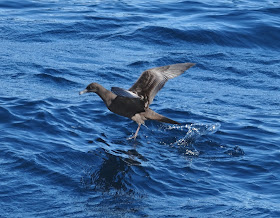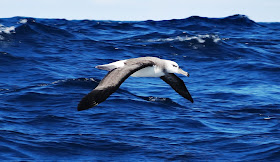 |
| Masked Booby |
We headed off in our catamaran, Cat-A-Pult, at 7am in conditions which remained relatively stable throughout the morning, with a 15 knot south-easterly wind - increasing to 18 knots in the early afternoon - and a swell of about 1.2m. The sky was clear, with the temperature ranging from 14 to 21 degrees. Wind conditions had been similar throughout the week so we were hopeful of something decent turning up.
 |
| Providence Petrel |
Our first Providence Petrel showed at 24 nautical miles offshore, and it proved to be the most common species seen during the day. A Fairy Prion and a few Common Noddies made their appearance as we approached the shelf. A small pod of Pantropical Spotted Dolphins was also seen. We cut the engine 31 nm offshore at 200m on the edge of the shelf, arriving there at 9.15am. We began drifting north, leaving a berley trail of shark liver.
 |
| Fairy Prion |
 |
| Fairy Prion |
 |
| Wedge-tailed Shearwater |
 |
| Australasian Gannet |
 |
| Masked Booby - Picture by Matthew Binns |
 |
| Black-browed Albatross |
 |
| Black-browed Albatross |
 |
| Humpback Whale |
PARTICIPANTS: Lachlan Tuckwell (skipper), Greg Roberts (organiser), Ian Barnett, Matthew Binns, Sarah Bevis, Chris Craig, Helena Craig, Mya-Rose Craig, Taryn Crispin, Alex Ferguson, Rod Gardner, Jim Macready, Kathy Wilk, Russell Yong.
SPECIES Total (maximum number at one time)
Black-browed Albatross 1 (1)
Providence Petrel 60 (20)
White-faced Storm-Petrel 1 (1)
Wedge-tailed Shearwater 1 (1)
Fairy Prion 12 (3)
Australasian Gannet 30 (5)
Masked Booby 1 (1)
Common Noddy 4 (2)
Crested Tern 20 (4)
Humpback Whale 6 (2)
Pantropical Spotted Dolphin 4 (2)










































